
How to Start a Website From Scratch: The Ultimate UK Guide
0
5
1
So, you’ve decided to start a website from scratch. Staring at that blank digital canvas can feel a little daunting, but it's really just a series of straightforward, manageable steps. Think of this guide as your practical roadmap, taking you from a simple idea to a fully functioning website ready to welcome UK visitors.
Let's cut through the jargon and get straight to it.
Your Blueprint for a Successful UK Website
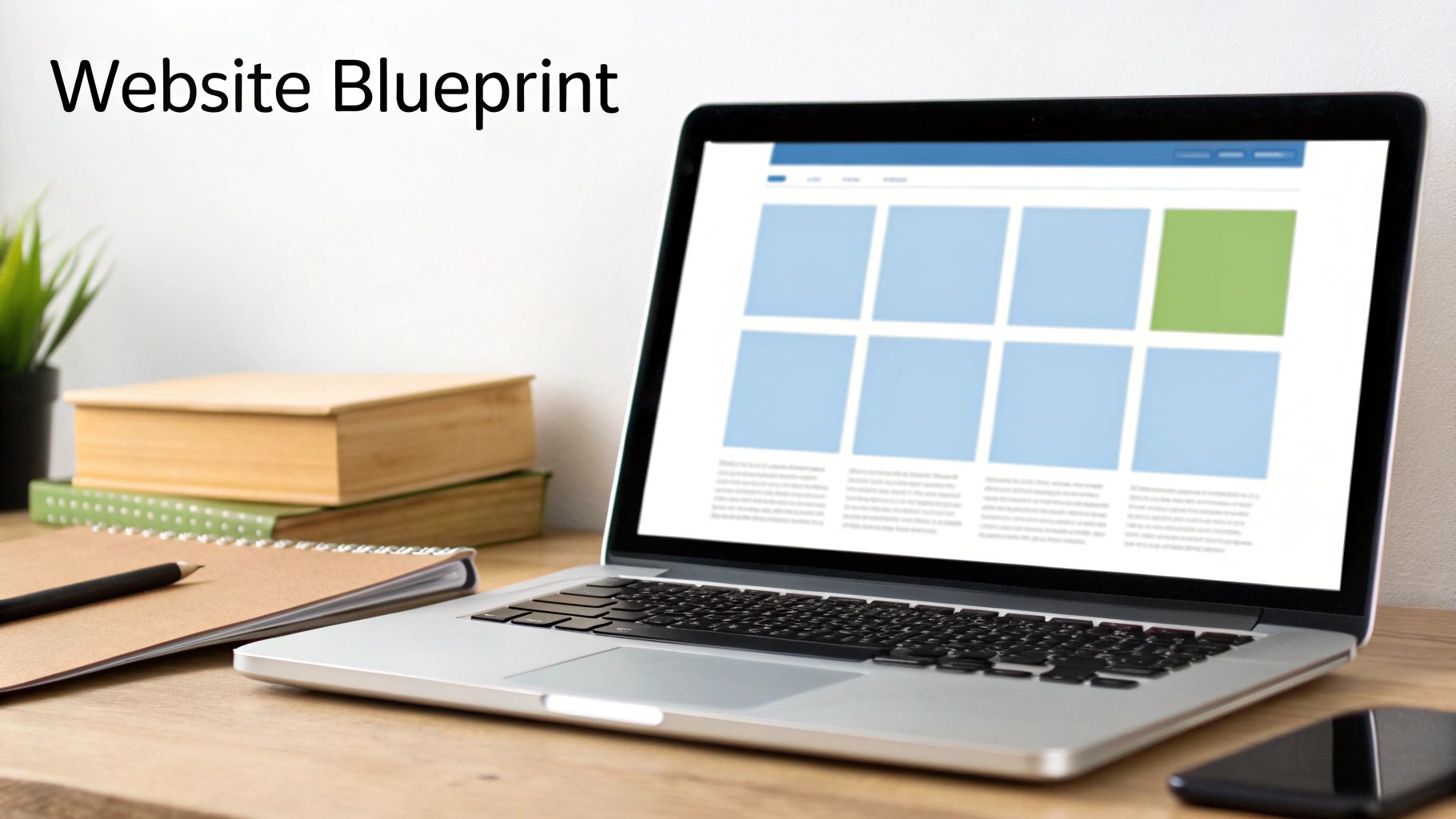
Before we even think about choosing a domain name or picking a design, we need to lay the groundwork. This initial stage is all about strategy – figuring out what you need your website to do and who you're building it for. Get this right, and everything else falls into place so much more easily.
First Things First: What's the Point of Your Website?
Before you even glance at colours or fonts, you need to answer one simple question: what is my website's primary goal? A clear purpose is your North Star, guiding every single decision from the layout you choose to the words you write.
What’s its main job?
Generate Leads: Is it a tool to collect contact details from potential customers for your service business?
Sell Products: Will it be an online shop where people can browse and buy directly? This is a whole discipline in itself, and if it's your goal, you'll want to understand how to build a website to sell stuff properly.
Showcase a Portfolio: Is it a gallery to display your incredible work as a photographer, designer, or writer?
Provide Information: Will it be a central hub of information for a community, club, or cause?
Nailing this down from the start saves you from costly mistakes and dead ends later.
A website without a clear goal is like a ship without a rudder. It might look impressive, but it won't get you anywhere meaningful. Every element, from the homepage headline to the contact form, should serve your main objective.
Why Your User Is the Real Boss
Once you know your "why," your focus has to shift immediately to your user. Building a site for a UK audience means understanding what they expect. This isn't just a nice-to-have; it's a commercial necessity.
User experience (or UX, as you'll often hear it called) is everything. A clunky, confusing website will send visitors packing. In fact, a staggering 88% of users are less likely to return to a site after a bad first impression. Ouch.
And it's not just about desktops anymore. Your site has to look and work brilliantly on phones and tablets, too. The data shows that sites properly optimised for mobile enjoy 22% lower bounce rates. In simple terms, people stick around longer.
Getting these two things right—your purpose and your user's needs—is the secret sauce. It’s how you build a website that doesn't just look good, but actually works.
To give you a clearer picture, let's break down the key ingredients you'll be dealing with.
The Core Components of Your New Website
Here's a quick rundown of the essential elements you'll need to get your website online and what each one does.
Component | What It Does | Key Decision |
|---|---|---|
Domain Name | This is your website's address on the internet (e.g., ). | Choosing a name that's memorable, relevant to your brand, and available. |
Web Hosting | The service that stores your website's files and makes them accessible on the web. | Selecting a reliable provider that offers good speed and support. |
CMS Platform | The software that helps you create and manage your website's content (e.g., WordPress). | Picking a platform that matches your technical skill and site goals. |
Think of these as the non-negotiables for getting started. They're the foundation upon which your entire online presence will be built. Ready to dive in and tackle the first real step? Let's go.
Claiming Your Digital Address and Foundation
Every great website starts with two fundamental pieces: a memorable domain name and a solid web hosting plan. Think of it this way: your domain is your street address, and hosting is the plot of land you build your house on. Getting these two right from the word go is a massive step towards ensuring your site is fast, secure, and successful.
Your domain isn’t just a technical detail; it’s a huge part of your brand. It’s what people will type into their browsers and share with friends. A killer domain name is short, easy to remember, and gives a clue about what you do. For any UK-based business, this immediately brings up a classic question: vs ?
Choosing Your Digital Postcode
A .co.uk domain is a brilliant way to signal that you’re a British-based business. It instantly builds a bit of trust and relevance with a local audience. In contrast, a .com has a much more global, international feel to it.
If your target market is purely in the UK, a .co.uk is often the smartest choice. But if you’ve got your sights set on selling internationally, grabbing the .com is a wise move, assuming it’s not already taken.
Finding the perfect name can be a proper creative challenge. Let's be honest, most of the obvious ones are long gone, so you might need to think a bit outside the box. For some more in-depth strategies, have a look at our guide on how to choose a domain name with tips for a winning brand. Once you’ve landed on an available name, registering it is dead simple and usually just involves a small annual fee.
With your address claimed, it’s time to sort out the land where your website will actually live. This is your web hosting.
Powering Your Website With the Right Hosting
Web hosting is basically the engine that keeps your website running and available to the world. It’s a service that stores all of your website’s files—your images, text, and code—on a powerful computer called a server. When someone types in your domain, that server sends all the files over to their browser. Simple as that.
The quality of your hosting has a direct impact on how well your site performs. Slow loading times will frustrate visitors and can seriously harm your search engine rankings. There are a few different types of hosting, each suited to different needs and budgets.
Shared Hosting: This is the most affordable option and is perfect for new blogs or small business websites. You’re sharing server space with other websites, which is what keeps the cost so low.
VPS (Virtual Private Server) Hosting: This is a step up. A VPS gives you your own dedicated slice of a server's resources. It’s a great middle-ground for growing websites that need a bit more power and control.
Dedicated Hosting: This gives you an entire server all to yourself, offering the best possible performance and security. It's usually reserved for high-traffic e-commerce stores or large corporate sites with heavy demands.
This infographic gives you a quick visual on the popularity of different domain extensions and hosting plans, along with the kind of uptime you should expect.
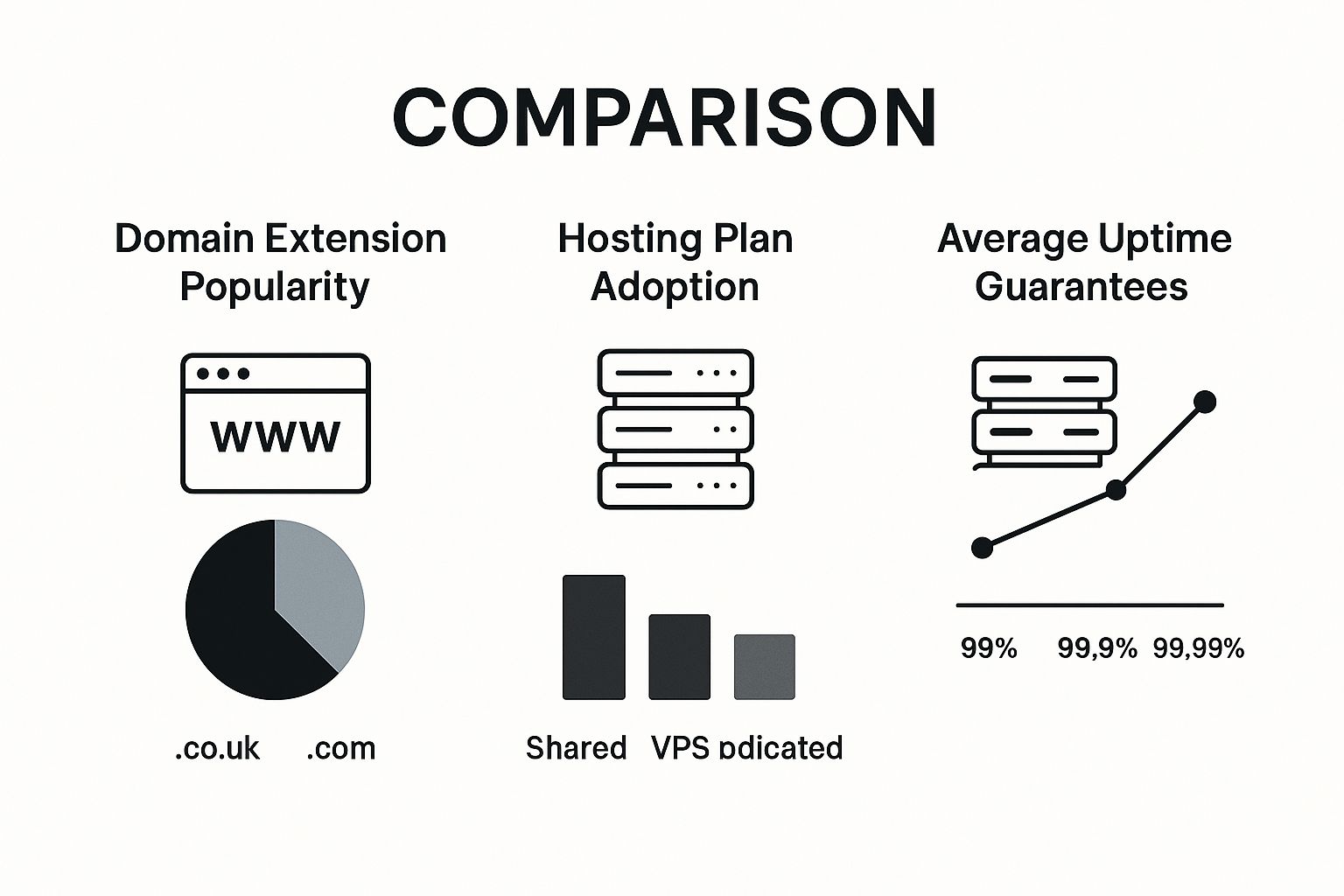
As you can see, while .com is a global giant, .co.uk is still a major player for anyone with a UK focus. And it’s no surprise that shared hosting is the starting point for most new websites.
What to Look for in a Hosting Provider
When you're choosing a provider, don't just go for the cheapest price tag. You need to consider a few critical factors to make sure you’re building on a solid foundation.
Uptime is probably the single most important metric for any hosting provider. An uptime guarantee of 99.9% is the industry standard. Honestly, anything less is a red flag, because frequent downtime means lost visitors and potential customers.
A good provider should also offer excellent customer support, because you will definitely have questions at some point. Finally, check that they offer scalability. Your hosting plan needs to be able to grow with you as your website's traffic increases. Making the right choice here will save you from some major headaches down the line.
Ready to take the next step and choose the software that will bring your vision to life? Let's explore the best platforms for actually building your site.
Choosing the Right Website Building Platform

Alright, you’ve got your domain name sorted and your hosting is ready to go. Now you've arrived at a crucial crossroads: choosing the software that will actually bring your website to life.
This isn't just some techy decision you can breeze past. The platform you pick will shape how you manage, grow, and interact with your site for years to come. Getting this right now saves you from a world of hurt (and a costly migration) down the road.
The two main paths you can take are a self-hosted Content Management System (CMS) like the ever-popular WordPress.org, or an all-in-one website builder like Wix or Squarespace. Each has its own vibe, and the best one for you boils down to your goals, technical confidence, and how much control you really want.
The Great Debate: WordPress vs Website Builders
WordPress.org is the undisputed heavyweight champion of the web, powering a staggering 43% of all websites. It’s open-source software, which means it’s free to use, but you need your own hosting (which we just covered) to get it running. Its greatest strength? Near-limitless flexibility.
With thousands upon thousands of themes and plugins available, you can build practically anything you can imagine. Simple blog? Easy. Complex e-commerce empire? No problem. But all that power comes with a steeper learning curve. You'll be in charge of updates, security, and backups, which can feel a bit daunting if you're a complete beginner.
On the other side of the ring, you have the all-in-one website builders. These platforms bundle everything—hosting, design, support, and software—into a single, neat monthly or annual fee. Their main selling point is simplicity. With slick drag-and-drop editors, you can create a professional-looking site without touching a single line of code.
Think of it like this: WordPress is a massive box of LEGO bricks with infinite possibilities, but no instruction manual. A website builder is like a high-quality LEGO kit, where the pieces are designed to fit together perfectly to create a specific, stunning model.
Matching the Platform to Your Purpose
The theoretical differences are one thing, but how does this actually play out? Let’s imagine a couple of scenarios.
First, picture a local artisan in Manchester who creates bespoke pottery. Her main goal is to showcase her work in a beautiful online gallery and maybe sell a few pieces. For her, a platform like Squarespace is a brilliant fit. She can pick a stunning, visually-focused template, easily upload her photos, and get her site live in a weekend. The all-in-one package means she doesn’t have to stress about the tech and can focus on her craft.
Now, think about a growing London-based startup. They plan to launch an online shop with hundreds of products, a members-only area, and a blog that needs advanced SEO tools to compete. For them, self-hosted WordPress with the WooCommerce plugin is the clear winner. It offers the heavy-duty e-commerce features and deep customisation they need to build a unique shopping experience and scale their operations.
Making an Informed Decision
Choosing between these two paths can feel overwhelming, so I've put together a simple table to help you compare them side-by-side. This should give you a clearer picture of which route aligns best with your needs.
Platform Comparison: WordPress vs Website Builders
Feature | WordPress.org | All-in-One Builders (e.g., Wix, Squarespace) |
|---|---|---|
Ease of Use | Steeper learning curve; requires more hands-on management. | Extremely beginner-friendly with drag-and-drop interfaces. |
Flexibility | Almost limitless. If you can think it, you can build it with plugins. | More structured; customisation is limited to the platform's tools. |
Maintenance | Your responsibility. You manage updates, security, and backups. | Handled for you. The platform takes care of all technical upkeep. |
Cost Structure | Lower initial cost (hosting + domain), but premium themes/plugins add up. | A single, predictable monthly or annual fee that includes everything. |
Ultimately, there is no single "best" platform—only the best platform for you.
Take a moment to be honest with yourself about your technical skills, budget, and long-term ambitions for your site. For an even deeper dive into the options, check out our guide on the 12 best website builder platforms for UK businesses in 2025.
Once you've made this foundational choice, you'll be perfectly positioned to move on to the fun part: designing your site and bringing your brand to life. Ready to start shaping your website's look and feel?
Designing Your Site and Crafting Core Content
Okay, you've picked your platform. Now for the fun part—making it look good. This is where your website stops being a technical project and starts becoming a visual representation of your brand. It’s your chance to make that all-important first impression.
It all kicks off with choosing a theme or template. Think of it as the architectural plan and interior design for your site, all rolled into one. It sets the stage for your layout, colours, fonts, and the general vibe a visitor gets the second they land on your page.
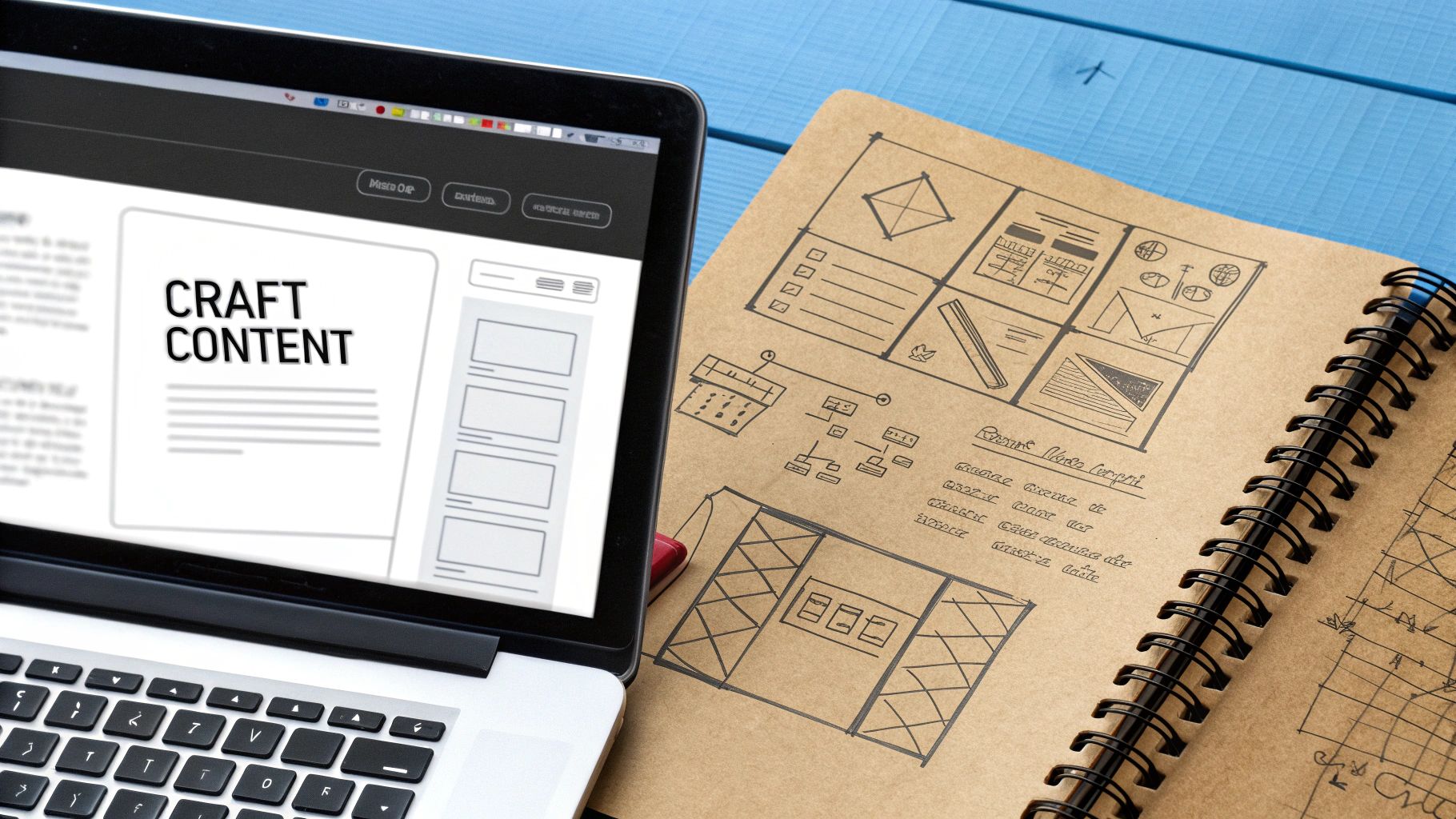
Finding a Theme That Reflects Your Brand
Whether you're in the WordPress dashboard or browsing a website builder's library, you'll be staring down the barrel of thousands of options. It can feel like trying to pick a single grain of rice from a sack. The trick is to narrow it down logically. Start by filtering for your industry—a photographer’s portfolio theme has very different needs from an e-commerce shop.
The image above gives you a classic taste of the WordPress theme directory. You can see how each one offers a completely different feel, from sleek and minimalist to something more bold and colourful.
Once you’ve got a handful of contenders, get picky and focus on what really matters:
Responsiveness: This isn't just a nice-to-have; it's essential. Your theme must be fully mobile-responsive. That means it looks and works perfectly on any screen, from a giant desktop monitor right down to a smartphone. No excuses.
Customisation Options: How much can you actually change without calling a developer? A good theme lets you easily tweak colours, switch fonts, and adjust layouts yourself. The more control, the better.
Ratings and Reviews: See what other people are saying. Don't just look at the star rating; read the comments. Consistent praise and recent updates are green flags for a quality, well-supported theme.
A great theme is just the starting block. The real personality comes from what you put inside it.
Structuring Your Site With Essential Pages
Every website that works well is built on a few core pages people just expect to see. Get these right, and you’re giving visitors a clear map to follow. You're telling your story, building trust, and gently guiding them where you want them to go.
Most sites need at least these four pages to get off the ground:
Homepage: Your digital shop window. It has to grab attention in about three seconds, explain what you do, and point people to the most important parts of your site.
About Page: This is where you drop the corporate act and be human. Tell your story. Who are you? What drives your business? People connect with people, not logos.
Services/Products Page: Time to get specific. What exactly do you sell or do? Use clear headings, bullet points, and great photos to make your offerings easy to understand and desirable.
Contact Page: Don't make people hunt for a way to get in touch. A simple contact form, email, phone number, and a physical address (if you have one) are all you need. Make it effortless.
Think of your website's navigation as a clear set of signposts. A visitor should never have to wonder where to click next. A simple, logical menu is one of the most powerful tools for creating a positive user experience.
Crafting Content That Connects and Converts
With your page structure sorted, it's time to fill in the blanks with words and pictures that actually mean something. Your copy should speak directly to your ideal customer, and your visuals need to back that message up. This is what turns a pretty design into a brand people trust.
The UK web design market is a serious business, pulling in a compound annual income of around £640.6 million. One of the big trends driving this is a focus on better user experiences through things like Progressive Web Apps (PWAs), which merge the convenience of a website with the slick feel of a mobile app. It just goes to show that a great design is nothing without engaging, seamless content to go with it. You can dig deeper into these industry stats in this detailed analysis of the UK web design market.
Finally, don't skimp on your visuals. Use professional, high-quality photos and graphics that match your brand's style. And one last pro tip: always, always optimise your images for the web before uploading them. Compressing them first will massively speed up your site’s loading time, which is crucial for keeping impatient visitors from bouncing away.
Feeling inspired to bring your own design to life? Our team specialises in creating stunning websites that not only look incredible but also deliver real results.
Launching Your Website and Getting Found Online
https://www.youtube.com/embed/xsVTqzratPs
You’ve designed your pages, crafted your content, and your website is looking sharp. The finish line is just ahead, but hold on – don’t hit that “publish” button just yet. A smooth take-off needs a thorough pre-launch check to make sure every single element works exactly as it should.
Launching is a huge milestone, but it's just the beginning. The real work starts now: getting people to actually find your brand-new site. This is where you'll dip your toes into the world of Search Engine Optimisation (SEO).
Your Pre-Launch Final Checks
Before you go live, you need to act like a first-time visitor. Go through your entire site with a fine-tooth comb. This final inspection can be the difference between a professional launch and a frustrating user experience.
Here’s a practical checklist to run through:
Test Every Link: Click on everything. Seriously. From your main navigation menu to the social media icons in your footer. Broken links are a dead end for users and a red flag for search engines.
Proofread Everything: Read every headline, paragraph, and button label out loud. You'd be amazed how many typos you'll catch. Grammatical errors can damage credibility in an instant.
Verify Your Forms: Fill out your own contact forms and any other sign-up forms. Did you get the submission email? Did the "thank you" message display correctly? Don't assume it works.
Check Mobile Responsiveness: This is non-negotiable. Grab your phone and tablet and navigate your entire site. Does it look great? Is the text readable? Is it easy to click on buttons?
Once these checks are complete and you feel confident, you're ready to go live.
Getting Found: The Basics of SEO
With your website live, how will anyone find it? The answer is SEO, the practice of helping your site appear higher in search engine results on platforms like Google. For a beginner, SEO can feel overwhelming, but the fundamentals are surprisingly straightforward.
It all starts with keywords. These are the phrases people type into Google when they're looking for what you offer. For example, a bakery in Bristol isn't just targeting "bakery"; they’re targeting "sourdough bread Bristol" or "best vegan cakes Bristol". You can use free tools like Google Keyword Planner to find the basic terms your audience is searching for.
Once you have a few keywords, you can start with on-page SEO. This just means placing those keywords naturally into key areas of your website. The two most important places are your title tags (the text that appears in the browser tab) and meta descriptions (the short summary that appears under your title in search results).
Your title tag and meta description are your website’s digital billboard. They are often the first interaction a potential visitor has with your brand, so make them compelling and relevant to what the user is searching for.
For a deeper dive into these concepts, our guide on search engine optimisation for beginners made simple breaks it all down into easy, actionable steps.
Setting Up Essential Tracking Tools
You can't improve what you don't measure. That’s why setting up two free, indispensable tools from Google is one of the most important post-launch tasks you'll do. They give you the data you need to understand your audience and track your site's performance.
Google Analytics: This tool tells you everything about your website's visitors. You can see how many people are visiting, which pages are most popular, how long they stay, and where they came from.
Google Search Console: This tool focuses on your site's health and performance in Google Search. It shows you which keywords are bringing people to your site, alerts you to any technical issues, and lets you monitor your site’s indexing status.
Setting these up is a one-time task that provides invaluable insight for months and years to come. Once your website is launched and you're tracking performance, implementing effective digital marketing strategies for small business growth is vital to attract visitors and achieve your online goals.
Ready to see your vision come to life? Our team can help you not only launch a beautiful site but also ensure it’s optimised to be found by your ideal customers from day one. Get in touch with us today for a free consultation.
Your Questions on Starting a Website Answered
Even with the best guide in the world, a few head-scratchers are bound to pop up when you decide to build a website from scratch. It’s completely normal.
To cut through the noise, we’ve rounded up the most common questions we hear from beginners and answered them straight. Think of this as your quick-fire FAQ, designed to sort out those lingering doubts so you can crack on with confidence.
How Much Does It Truly Cost to Start a Website in the UK?
This varies wildly, but it's often a lot less than people think, especially if you’re happy to get your hands dirty. For a solid, professional-looking website using something like Squarespace or WordPress with shared hosting, you can realistically get up and running for between £100 to £200 for the first year.
That initial cost typically breaks down into three main chunks:
Your domain name: Budget around £10-£15 for a domain.
A year of web hosting: Decent shared hosting plans usually fall somewhere between £50 and £100 per year.
A premium theme or template: This is a one-off cost, often around £40-£60.
Of course, if you start adding fancy e-commerce features or decide to bring in a professional designer, the price tag can climb into the hundreds or even thousands. Just don’t forget to factor in the annual renewal costs for your domain and hosting – they’ll be back every year!
How Long Does It Take to Build a Website From Scratch?
Honestly? It depends. The real answer comes down to two things: how complex your site is and how much time you can actually dedicate to it.
A simple 5-page 'brochure' site for a local business could be knocked out in a weekend with a website builder, assuming you’ve got all your text and images ready to go. On the other hand, a more ambitious project with an online shop, custom features, or a massive blog could easily take several weeks, if not months, to get right.
For most beginners putting together their first small business site, I’d say set aside 2 to 6 weeks. That gives you enough breathing room to learn the platform, nail the design, write decent content, and test everything properly before you go live.
Do I Need to Know How to Code to Build a Website?
Absolutely not. This is probably the biggest myth out there, but modern tools have completely busted it. Today, anyone can build a website, regardless of their technical background.
Website builders like Wix and Squarespace use intuitive drag-and-drop editors that feel more like putting together a presentation than doing anything technical. Even a powerhouse like WordPress lets you build a stunning, fully-functional site using themes and plugins, all without ever needing to write a single line of code.
You'd only need to touch code if you wanted some incredibly specific, custom feature that a plugin couldn't provide. For 99% of new websites, it's a total non-issue.
What Should I Focus On Right After Launching My Website?
The second your site is live, your job isn't done. Your focus needs to pivot immediately to two things: promotion and analytics. Because let's be real, a website is pretty useless if nobody sees it.
Start getting the word out. Share your new site on social media, send an email to your mailing list, and list it in relevant local directories. At the same time, get Google Analytics hooked up and keep an eye on the data. It will tell you who’s visiting, how they found you, and what pages they’re actually reading. That insight is pure gold for figuring out what's working and how to grow your audience over time.
Feeling a bit clearer on these common questions? If you're ready to take the next step and make sure your new website is built for success, our team at Baslon Digital is here to help. Contact us for a free, no-obligation chat about your project today.
Your Website is Live! Now What? Don’t Let It Die.
So, you’ve launched your website. Massive high-five to you! That’s a huge milestone. But let's be real for a second: hitting 'publish' is the starting line, not the finish. Now the real work begins.
You can't just let that shiny new site sit there collecting digital dust. It needs to be a living, breathing asset that actually works for you. Just like a physical shop needs its windows cleaned and stock refreshed, your digital storefront requires a bit of TLC to stay secure, functional, and relevant.
Keeping Your Website Alive and Growing
To keep people coming back—and to keep Google interested—your site needs to feel alive. A stagnant website is a dead website in the eyes of a search engine.
This is where a content strategy comes in. Don't panic, it's not as scary as it sounds.
Start a Blog: Honestly, this is one of the best things you can do. Regularly publishing articles that your target audience actually wants to read shows you know your stuff. It also gives Google fresh content to index, which is like SEO gold.
Update Your Portfolio: If you're a creative, make it a habit to add your latest projects. An out-of-date portfolio screams "I haven't had work in years."
Refresh Your Main Pages: Take a look at your "About" and "Services" pages every few months. Does the text still sound right? Could it be punchier? Are your offerings still accurate?
A website is a living document, not a brochure you print once and forget about. Its value comes from evolving and constantly meeting the needs of your visitors. The "set it and forget it" approach is the fastest way to become invisible online.
Your next power move? Dipping your toes into digital marketing. Think about starting an email list to keep in touch with potential customers or using social media to drive traffic directly to your new blog posts. This is how you amplify everything you’ve just built.
Ready to turn your new website into a powerful growth engine for your business? Building it is just the first step. The team at Baslon Digital specialises in creating and executing ongoing growth strategies that deliver real results. Don't let your investment go to waste. Visit us at https://www.baslondigital.com today to find out how we can help you thrive online.
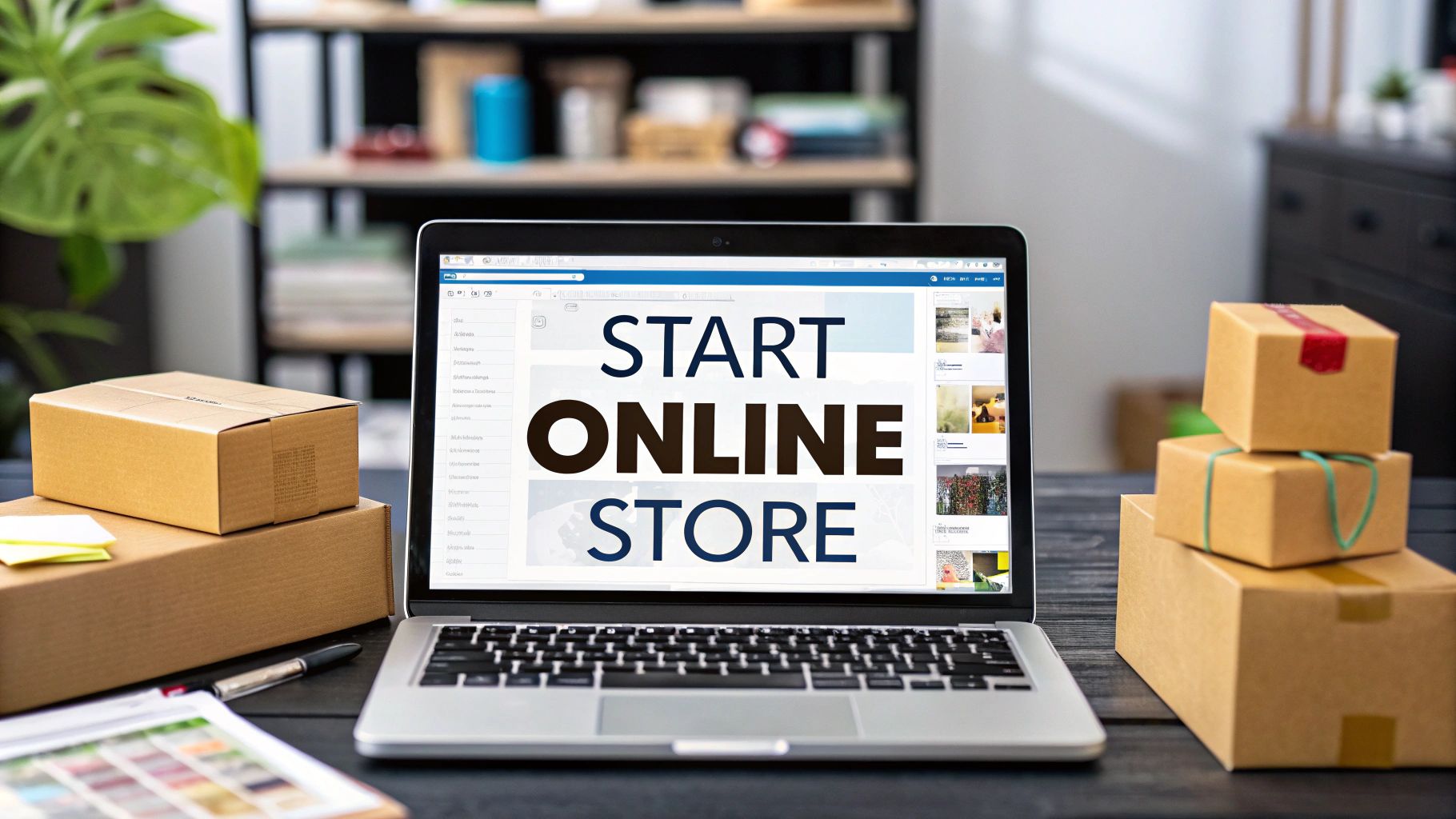
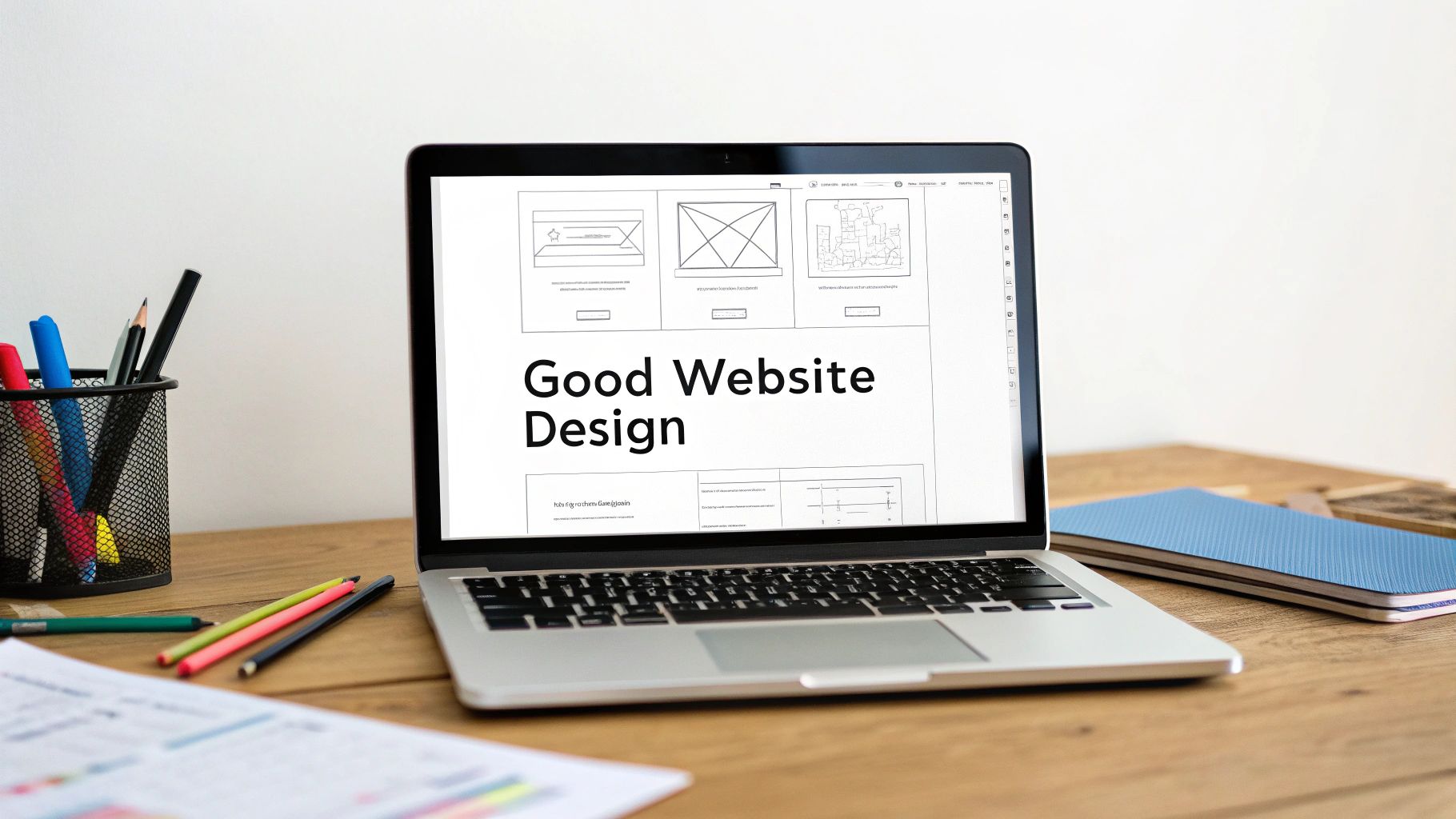


Elevate your home with the latest sofa designs from Abhi and Oak. Looking for that perfect blend of luxury and practicality? Explore our stylish collection, featuring the sleek, modern appeal of a leatherette sofa set. Designed for comfort and built to last, these pieces are ideal for any contemporary living space. See all the new arrivals and find your statement furniture piece on our website today.